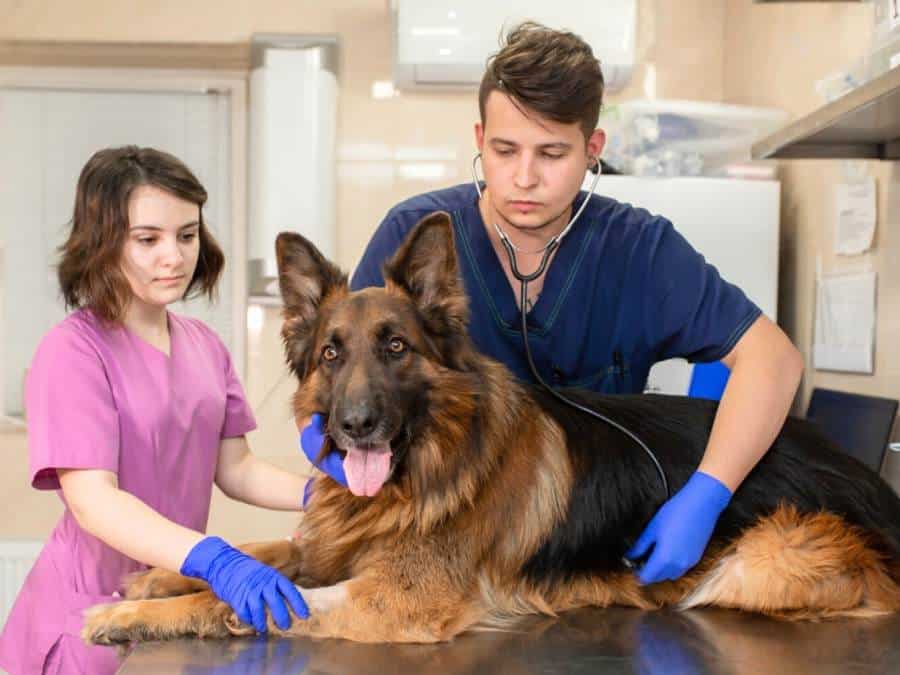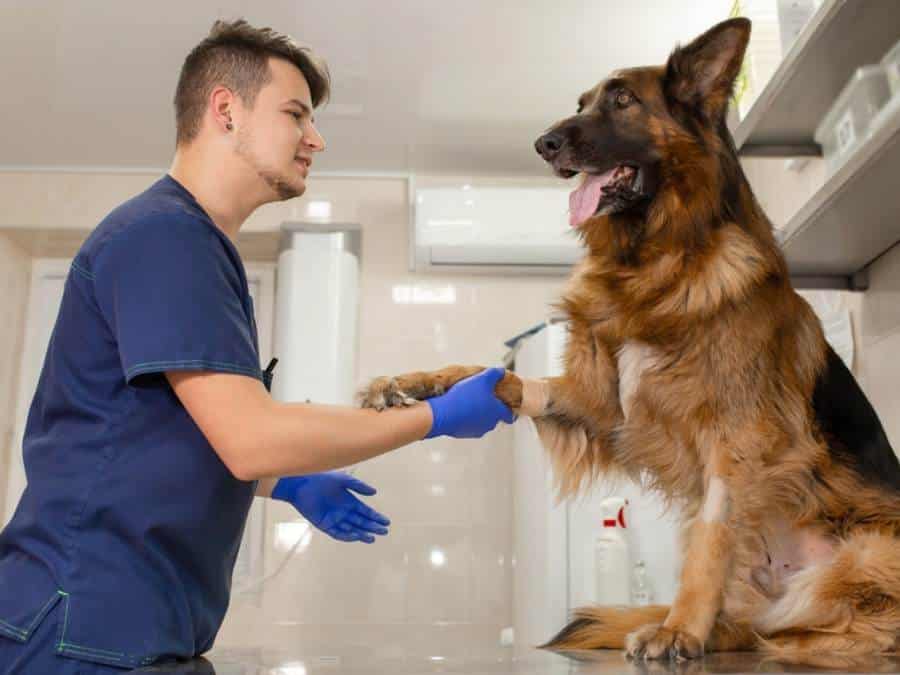If you have recently noticed your German Shepherd rubbing himself against furniture or experiencing persistent itching and irritation, the reason could be skin yeast infection.
Yeast dermatitis, caused by overgrowth of yeast organisms on the skin, can lead to discomfort and irritation for your furry friend. Identifying the signs early on can help prevent further complications.
What is German Shepherd Skin Yeast Infection?
Yeast infections or Malassezia dermatitis caused by the fungus Malassezia pachydermatis can be a common problem for German Shepherds, leading to discomfort and irritation. These infections occur when there is an overgrowth of yeast on the dog’s skin.
Yeast, specifically the Malassezia species, is naturally present on the skin of dogs, including German Shepherds.
However, under certain conditions, such as an imbalance in the skin’s pH levels or a weakened immune system, this yeast can multiply rapidly and cause an infection.
When yeast overgrows on a dog’s skin, it can lead to dermatitis – inflammation of the skin. The warm and moist areas of a dog’s body are particularly prone to yeast growth, such as the ears, paws, armpits, and groin area.
The excessive growth of yeast can result in redness, itching, hair loss, and a distinct odor.
Symptoms of Yeast Infection in German Shepherds
Yeast dermatitis, or a yeast infection, can cause a range of uncomfortable symptoms in German Shepherds. Recognizing these symptoms is crucial for early detection and prompt treatment. Here are the common signs to look out for:
1. Redness, Itching, and Inflammation: You may notice your dog scratching or biting at certain areas excessively. These symptoms can be distressing for your furry friend and may lead to further complications if left untreated.
2. Presence of greasy or waxy skin with an unpleasant odor: As the German Shepherd skin yeast infection progresses, you may observe that your German Shepherd’s skin becomes greasy or waxy. This change in texture often accompanies an unpleasant odor.
3. Hair Loss, scabs, and sores: In more advanced stages of yeast dermatitis, hair loss may occur in affected areas. Your German Shepherd might develop scabs and sores due to constant scratching and irritation.
4. Scales and crusty, flaky skin: You might notice crusty patches forming on your German Shepherd’s skin. This rough texture is a result of inflammation caused by the overgrowth of yeast organisms.
RELATED: German Shepherd Pyoderma Treatment at Home
5. Thickened Skin (‘Elephant Skin’): If left untreated for an extended period, yeast infections can cause thickening of the skin known as “elephant skin.” This condition occurs due to chronic inflammation caused by excessive scratching and bacterial invasion secondary to yeast overgrowth.
6. Hyperpigmentation (Darkly pigmented skin): The affected areas may appear darker than the surrounding healthy skin due to chronic inflammation and increased melanin production.
7. Chronic or Recurrent otitis externa or Ear infections: Common symptoms include itching, redness, discharge, and a foul odor emanating from the ears. If your dog experiences recurring ear infections, it may be indicative of an underlying yeast problem that requires thorough treatment.
RELATED: Dry & Flaky German Shepherd Itchy Skin Treatment

Home Remedies for Treating Yeast Infections in GSDs
While it’s important to consult with a veterinarian for a proper diagnosis and treatment plan for your dog’s yeast infection, there are some home remedies and supportive measures that may help alleviate symptoms or complement veterinary treatment.
Keep in mind that these suggestions are not substitutes for professional veterinary care:
1. Apple Cider Vinegar (ACV) Rinse
Some pet owners use a diluted solution of apple cider vinegar to rinse affected areas. Mix one part apple cider vinegar with one part water and use a soft cloth or cotton ball to apply it to the affected skin.
However, this should be done cautiously, and it’s essential to monitor your dog for any signs of irritation.
2. Coconut Oil
Coconut oil is another excellent natural antifungal remedy. Its lauric acid content helps fight against yeast overgrowth by disrupting its cell membranes. Applying coconut oil topically to the affected areas can soothe irritation and promote healing.
3. Epsom Salt
Epsom salt baths are not only relaxing for dogs but also beneficial for treating yeast infections. The magnesium sulfate in Epsom salt helps reduce inflammation and kill off yeast.
Dissolve half a cup of Epsom salt in warm water and let your dog soak in it for 10-15 minutes before rinsing thoroughly.
4. Turmeric
Turmeric, a spice known for its anti-inflammatory properties, can also aid in fighting yeast infections.
You can mix turmeric with coconut oil to create a paste and apply it to the affected areas of your dog’s skin. This combination will help reduce inflammation and inhibit the growth of yeast.
5. Diluted Tea Tree Oil
Tea tree oil is a potent antifungal agent that can be used to treat yeast infections in dogs; however, caution must be exercised as it should never be ingested or applied directly at full strength.
Diluting tea tree oil with water or carrier oils like coconut oil before applying it topically is crucial to prevent any adverse reactions.
6. Herbal Shampoos
Using herbal shampoos containing ingredients like tea tree oil, neem oil, or lavender oil can also provide soothing relief for German Shepherds with yeast infections.
These shampoos have antifungal properties that can help reduce the overgrowth of yeast on the skin and alleviate itching and discomfort.
7. Incorporating Probiotics into the Dog’s Diet
Probiotics are beneficial bacteria that can help restore balance to your dog’s gut flora, which plays a crucial role in preventing yeast overgrowth.
Adding probiotic supplements or feeding your dog foods rich in natural probiotics, such as yogurt or kefir, can promote a healthy gut environment and support the immune system in fighting off yeast infections.
8. Regular Cleaning
Keep the affected areas clean and dry. Gently clean the skin folds, ears, and any affected areas with a mild, pet-safe cleanser recommended by your veterinarian.
RELATED: How to Cure German Shepherd Dandruff

How to treat yeast infection in the dog’s ear?
Make sure to clean your dog’s ears every day to prevent dirt, wax, yeast, and bacterial infections. If the ears are already clean and dry without any unpleasant smell, you can skip cleaning them for a day or two. The best option for cleaning is to use a dog ear cleaner with a drying agent or witch hazel with cotton balls.
How to treat yeast infection in the dog’s paws?
To tackle a yeast infection on your German Shepherd’s paws, you can treat their paws by dipping them in a solution made from 1 cup of hydrogen peroxide, ¼ cup of white vinegar, and 1 gallon of water.
After dipping, make sure to pat their feet dry. You can repeat this process daily or as needed to effectively combat the infection.
How to treat yeast infection on the dog’s body?
If your dog’s skin has yeast patches, you should clean his body every day with anti-fungal shampoo. Make sure to avoid using shampoo that contains oatmeal because grains can nourish the yeast.
Causes of Yeast Infections in German Shepherds
Yeast infections in German Shepherds can be caused by various factors. Here are some common causes and risk factors to be aware of:
1. Imbalanced Microflora: German Shepherds, like all dogs, have a natural balance of microorganisms in their bodies.
When this balance is disrupted, it can lead to an overgrowth of yeast. Factors that can contribute to an imbalanced microflora include a weakened immune system, poor nutrition, and certain medications.
2. Moisture and Warmth: Yeast thrives in warm and moist environments. German Shepherds with thick coats or folds of skin are more prone to yeast infections because these areas provide an ideal breeding ground for yeast.
Keeping your dog’s skin clean and dry can help prevent yeast overgrowth.

3. Allergies: German Shepherds are known to be prone to allergies, including food allergies and environmental allergies.
Allergies can weaken the skin barrier and make it more susceptible to yeast infections. Identifying and managing your dog’s allergies can help reduce the risk of yeast dermatitis.
Click here to read more about food allergies in German Shepherds.
4. Poor Hygiene: Neglecting proper hygiene practices can increase the likelihood of yeast infections. Regular grooming, including bathing, brushing, and cleaning the ears, is essential for maintaining a healthy skin and coat.
Failing to clean these areas regularly can create an environment where yeast can thrive.
5. Underlying Health Conditions: Certain health conditions can make German Shepherds more susceptible to yeast infections.
These include hormonal imbalances, diabetes, Cushing’s disease, and autoimmune disorders. Managing these underlying conditions is important for preventing recurring yeast infections.
6. Environmental Factors: German Shepherds that spend a lot of time in humid or damp environments are at a higher risk of developing yeast infections. This includes dogs that live in areas with high humidity or those that swim frequently.
7. Genetic Predisposition: Some German Shepherds may have a genetic predisposition to yeast infections. If your dog has a family history of recurring yeast infections, it’s important to be extra vigilant in preventing and managing these infections.
It’s important to note that while these factors can contribute to yeast infections, each dog is unique, and the specific cause may vary. If you suspect your dog has a yeast infection, it’s crucial to consult with a veterinarian for an accurate diagnosis and appropriate treatment.
RELATED:

Diagnosing a German Shepherd’s Yeast Infection
When it comes to diagnosing a dog’s yeast infection, it’s best to leave it to the professionals. A veterinarian is trained to identify the signs and symptoms of a yeast infection and can provide an accurate diagnosis.
Here’s how a vet typically goes about diagnosing a dog’s yeast dermatitis:
There are several techniques used to collect samples for diagnosing yeast dermatitis:
- Skin scraping – Using a dull blade to collect yeast organisms by scraping the skin.
- Impression smear – Putting a slide on the skin to get yeast organisms.
- Cotton swab sample – Rubbing a wet swab on the skin to gather yeast organisms.
- Acetate tape preparations – applying a piece of clear tape to the skin to collect yeast organisms.
- Skin biopsy – To diagnose a skin yeast infection, a small piece of skin can be obtained using a biopsy punch. Although this test is invasive, it provides comprehensive diagnostic information. The extracted skin sample is then sent to a veterinary pathologist for examination.
Your vet can examine most samples in the clinic using a microscope. If your dog has a yeast allergy, your vet or dermatologist may suggest doing blood and/or skin tests to confirm the diagnosis.

Treatment Options for Canine Yeast Dermatitis
Fortunately, there are several effective treatment options available to alleviate the symptoms of canine yeast dermatitis. Veterinarians often prescribe antifungal medications as the primary therapeutic option for treating these infections.
1. Antifungal Medications
Antifungal medications play a crucial role in combating yeast infections in dogs. These medications are specifically formulated to target and eliminate the fungal overgrowth responsible for causing skin irritation and discomfort.
Commonly prescribed antifungal medications include itraconazole, fluconazole, and ketoconazole.
These oral treatments work by inhibiting the growth of yeast cells within the dog’s body. They are typically administered daily or as directed by the veterinarian.
2. Topical Treatments
In addition to prescription medications, the vet may recommend topical treatments to address localized infections. This could include antifungal creams or ointments that are applied directly to the affected skin or ears.
3. Ear Cleaners
For yeast infections in the ears, the veterinarian may prescribe a specialized ear cleaner to remove excess wax and debris. These cleaners often have antifungal and antibacterial properties to help treat and prevent further infections.
4. Medicated Shampoos
Medicated shampoos containing antifungal agents may be prescribed for dogs with yeast infections on their skin and coat. Regular bathing with these shampoos can help manage the infection.
5. Dietary Changes
In some cases, the vet may suggest dietary changes to address underlying factors contributing to the yeast infection. This may involve switching to a hypoallergenic or low-carbohydrate diet.
Incorporating high-quality protein sources, probiotics, omega-3 fatty acids, and limited carbohydrates may help strengthen your dog’s immune system and promote overall skin health.
6. Probiotics
To restore a healthy balance of microorganisms, including bacteria and yeast, in the dog’s body, the vet may recommend probiotic supplements. Probiotics can support the immune system and help maintain a healthy microbial balance.
It’s crucial to follow the veterinarian’s instructions carefully and complete the full course of prescribed medications, even if the symptoms improve before the treatment is finished.
Additionally, the vet may recommend follow-up appointments to monitor the dog’s progress and make adjustments to the treatment plan if necessary.

How to Prevent Yeast Infections in German Shepherds?
Preventing yeast infections in German Shepherds involves a combination of good hygiene practices, proper grooming, a balanced diet, and addressing potential underlying factors.
Here are some general guidelines to help prevent yeast infections in dogs:
- Regular Bathing and Grooming:
- Bathe your dog regularly using a mild, pet-friendly shampoo. Be sure not to over-bathe, as excessive bathing can strip the skin of natural oils.
- Pay special attention to cleaning and drying skin folds, especially in breeds prone to skin folds, to prevent moisture buildup.
- Keep Ears Clean and Dry:
- Regularly check your dog’s ears for signs of redness, swelling, or discharge.
- Clean your dog’s ears as recommended by your veterinarian, using a vet-approved ear cleaner to prevent yeast overgrowth.
- Dietary Management:
- Feed your dog a well-balanced and nutritionally complete diet. Consult with your veterinarian to choose a diet that meets your dog’s specific needs.
- Consider a diet with limited carbohydrates and sugars, as excessive amounts can contribute to yeast overgrowth.
- Probiotics:
- Incorporate probiotic supplements into your dog’s diet to support a healthy balance of gut flora. Probiotics can help maintain a strong immune system.
- Allergy Management:
- Identify and manage any allergies your dog may have, whether they are related to food or environmental factors. Allergies can weaken the immune system, making dogs more susceptible to yeast infections.
- Avoid Overuse of Antibiotics:
- Use antibiotics judiciously and only under the guidance of a veterinarian. Antibiotics can disrupt the balance of microorganisms, potentially leading to yeast overgrowth.
- Environmental Control:
- Maintain a clean living environment. Regularly clean your dog’s bedding, toys, and living areas to reduce the presence of allergens and potential sources of infection.
Schedule regular checkups with your veterinarian to monitor your dog’s overall health. Early detection and treatment of underlying issues can prevent the development of yeast infections.
Conclusion
In conclusion, yeast infections can be a frustrating and uncomfortable condition for German Shepherds. Understanding the causes, symptoms, and treatment options is crucial in providing relief and preventing recurrence. By implementing effective treatment methods and incorporating preventive measures, you can help your furry friend overcome yeast dermatitis and enjoy a healthier, happier life.




